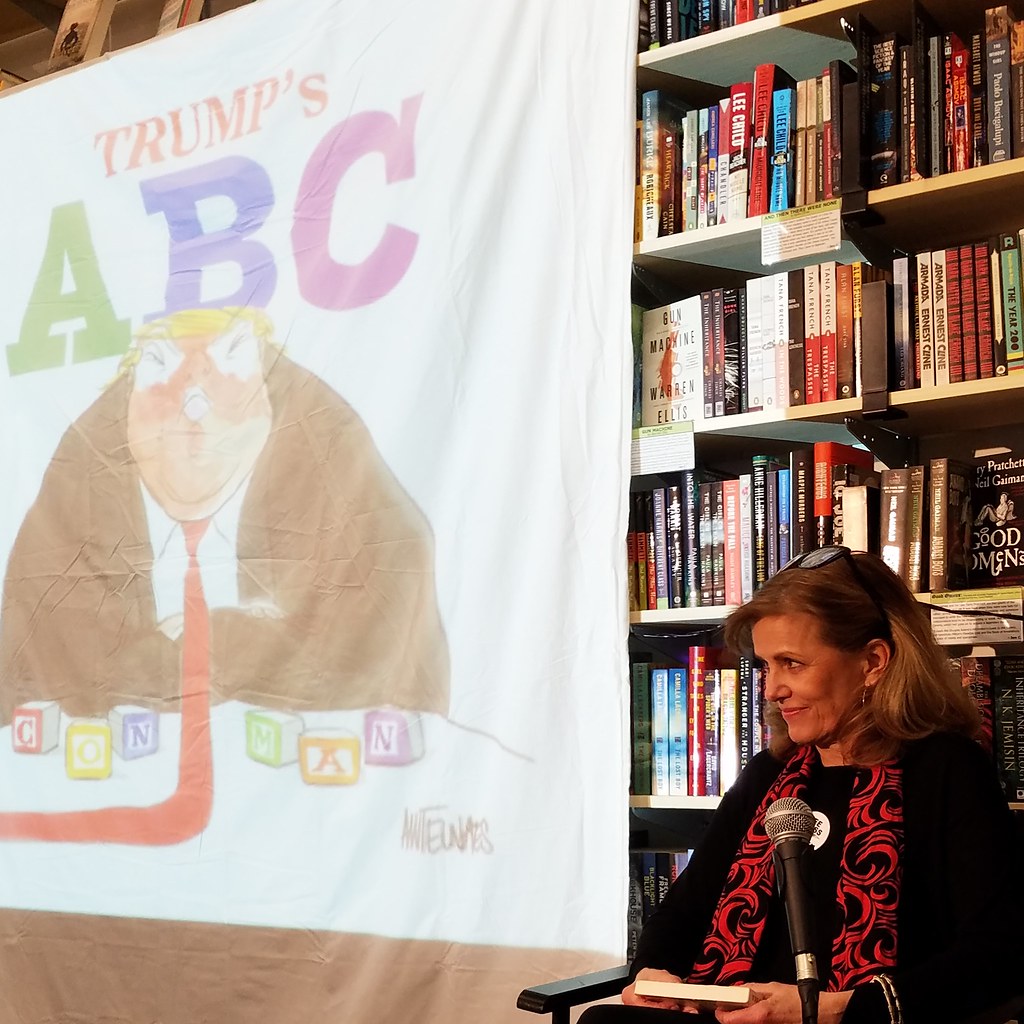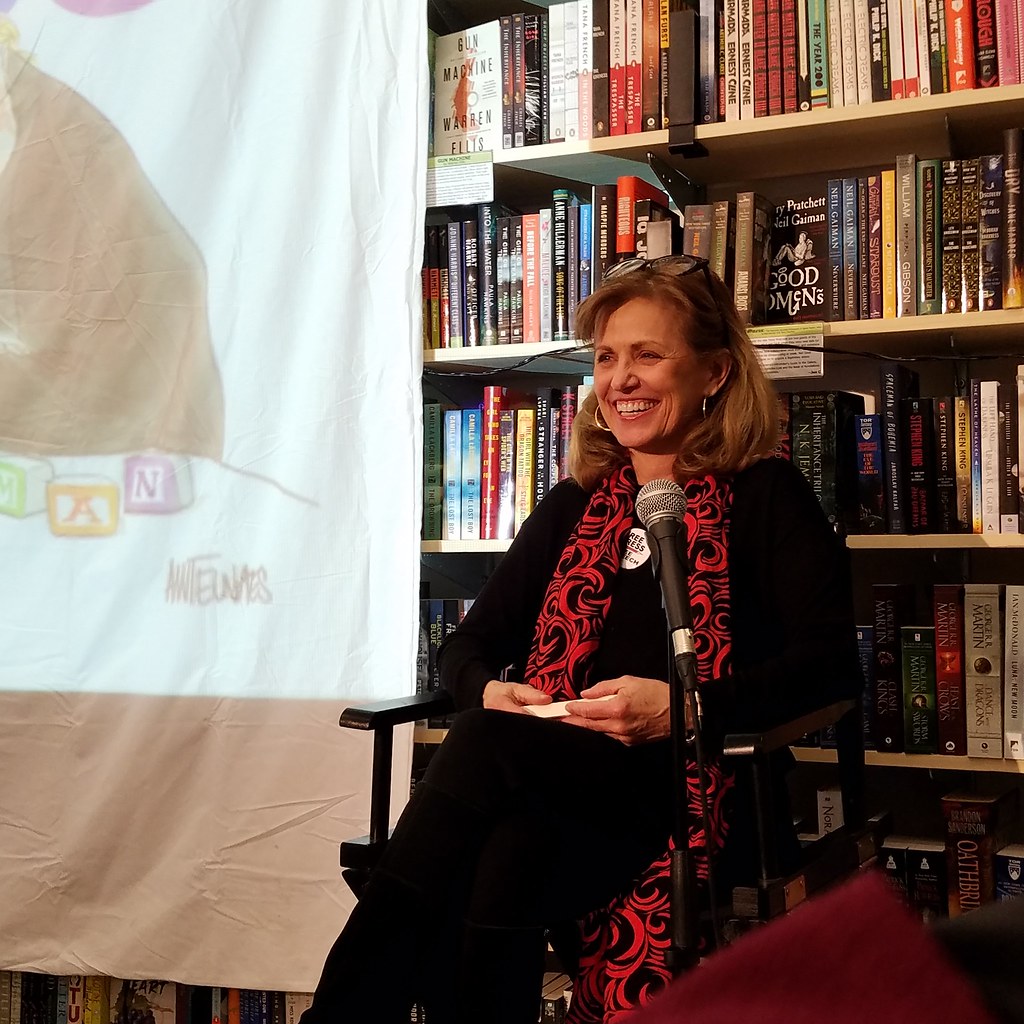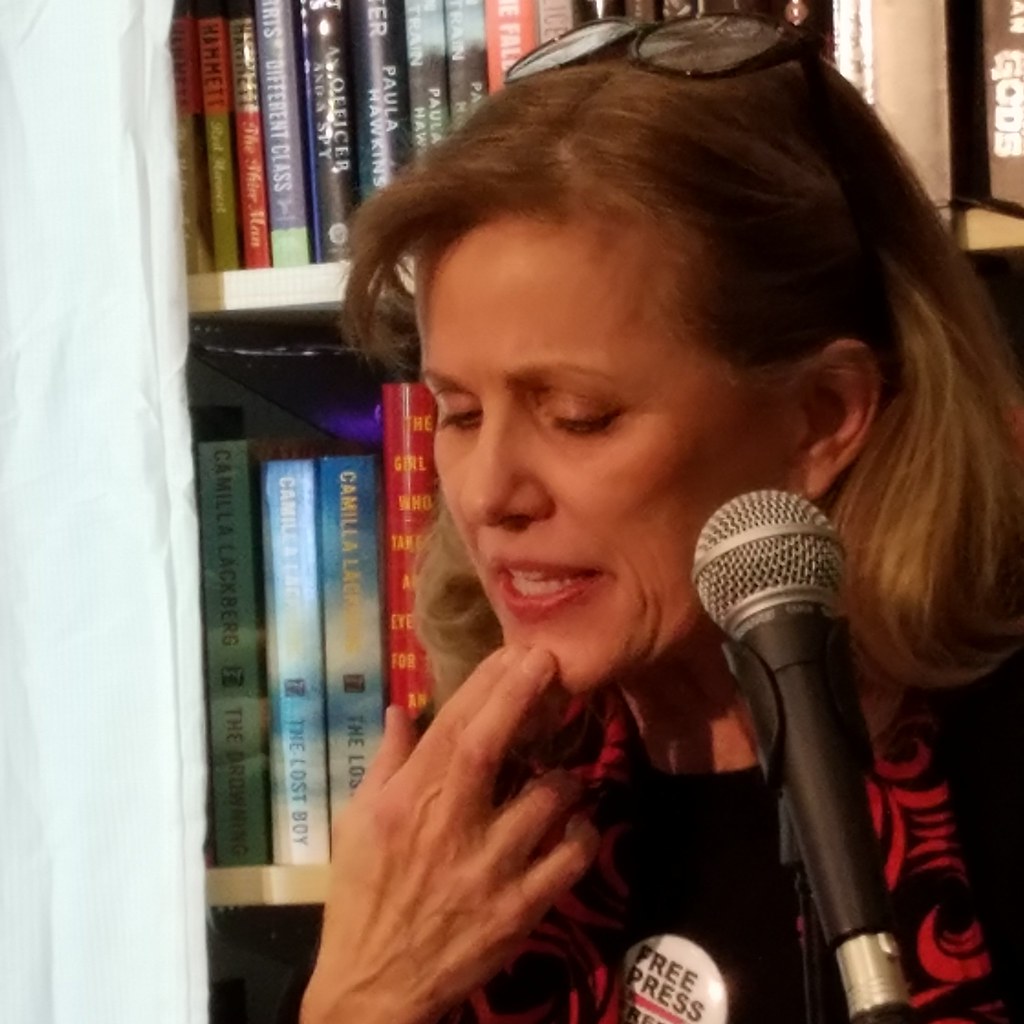 After she read Trump's ABC
After she read Trump's ABC,
her new book of caricatures about the administration, Ann Telnaes took questions from the audience for about thirty minutes. With her permission, I've transcribed them.
I’ll tell you a little about his book came about. I did not plan to do an ABC book. I had done a lot of sketches in 2016, especially during the primaries and debates, and I originally tried to get a book published of those sketches. My book agent went around, still during the primaries when most people thought Hillary was going to win the presidency (myself included), and couldn’t get any interest. People were already tired of it, and thought Hillary was going to win, so the feedback from publishers was, “We’d like to see a Hillary book.” I thought, “Ok, I can try that – this will be interesting - first female president” – but for some reason, I had this nagging feeling and I just couldn’t come up with something. Of course then the election happened and most of us were surprised, and I thought everybody would be interested in a Trump book. But you’d be amazed at how many publishers didn’t want to do a Trump book – at least an editorial cartooning book.

I put it aside and I happened to take a road trip down to Savannah during the holidays. I had a nine hour drive down and a nine hour drive back. I was driving, because my dog doesn’t, and I didn’t have my hands free to do any sketches. I was thinking about a suggestion a friend had given me, which was to do a political ABC book. Since my hands weren’t free, I put my phone on, and started to recite, “A is for blah, B is for blah...” and I kept doing that all the way down to Savannah and all the way back up. By the time I got back to D.C. I had a book.
Which was amazing, because the hardest thing for me is to let go and let that new thing happen. When you get something in your head – I had a different type of book in my head – but once I let go of it, and I went with what I was thinking, it just came. That was a surprise, a nice surprise. I took a few hours and did some sketching. By chance I was giving a talk at the
Center for Cartoon Studies in Vermont, and I was talking to
James Sturm the co-founder of the college. He looked at my sketches and said, “I’ll put you in touch with
Fantagraphics.” I had an email exchange with publisher Gary Groth and it was great. He said, “Yeah, let’s do it” and that’s how the book came to be.
The rhymes were done by the beginning of 2017, and the artwork was finished by May, and I was a little concerned that it wouldn’t hold up. There are some things that obviously aren’t in here, but I’m pretty pleased with it. I’m happy I did it.
Q: How has your image of Trump changed as he’s gone from being the joke candidate to being the actual president? How has your portrayal changed? I know the tie has gotten longer.
Yes, the tie is wonderful. The tie is the prop that keeps on giving. I’m still playing with that tie.
You know, I didn’t really think of him too much as a joke in the beginning. I had done a couple of Trump cartoons before when he ran earlier that were more joke-like, but when he announced this time, I actually did a cartoon where he was saying, “Me, me, me” all the time, because his run for president was all about him. I think in terms of how he looks physically – to me caricatures are more about who the person is. The more that I listen to him, and the more that I realize that this is all about him, that has developed my caricature.
A difference in the last couple of years is that I’ve gone back to doing colors by hand instead of on the computer. Watercolor is a wonderful medium for accidents. I don’t even know how to use watercolor, but it doesn’t matter.
Q: On your road trip where you composed the book, did you have any ideas that were too angry or obscene to include, and if so, will you share them now?
Probably, but I don’t remember them. Actually, it’s amazing. Except for a couple of letters, I pretty much kept to it. The only one I remember going back and forth on was the “K is for Killing without a new plan,” about Obamacare. At that time, they were just in the middle of trying to kill it and I wasn’t sure if I should say they killed it, or didn’t, so I decided that they’d try to kill it, but they still haven’t killed it yet.
Q: Would you consider doing sequels for other years if he lasts that long? Every day there’s some new crazy story…

Oh god. You’re right. The only thing I find wanting in this book is that there’s other things I want to address. Maybe I can do a counting book.
Obviously I had to make a decision what I was going to do for each letter, and there were certain things I wanted to make sure I got in there, like the separation of powers, and I had to include something about his appearance and his hair, even though that’s kind of silly. People would notice if that wasn’t in there. I wanted to hit specific things. Using “pussy” was deliberate on my part – this is something new. I work for the
Washington Post, and I had to ask if I could use that word. I can tell you that they wouldn’t have allowed me to use it in any other situation, but once the President says it, I’m allowed to use it. And now I use it.
Yes, now for another book I could use “shithole countries.”
 Q: Since Trump is famously thin-skinned, do you know to what extent he has objected to your cartoons?
Q: Since Trump is famously thin-skinned, do you know to what extent he has objected to your cartoons?
Let’s broaden that and say, “Has he reacted to any editorial cartoonists?” Not that I know. I honestly think it’s because the man doesn’t read. He gets his information from television. We’re not on television and I think that’s the reason he has noticed us. There’s been plenty of work out there that has been hard-hitting against him.
Q: Did Fantagraphics come up with the board book format, or was that something you came into the deal with?
No, actually that was something they had to sell me on. I draw very large, and I tend to want my work printed large. At first I thought it would be a bigger book, but I had a really great designer, Jacob Covey, and he and Gary Groth were both telling me that we needed to do this as a board book. I said, “I don’t know, that’s kind of small,” but when I saw it and held it my hand, I thought, “Yeah, this will work!” I’m really pleased that they convinced me to do it this way because I think it’s perfect.
I draw large. The reason I draw large is because I have an art background. We were encouraged in art school during life drawing classes to draw from the shoulder and not from the wrist. So I’m always doing this [as she makes a big sweeping motion with her arm]. I always feel I draw better larger. It takes more time, but I feel I get a better end product.
Q: The rhyming flows well – was that hard to do?
I’m not a writer. Maybe because I was in the car… I had a lot of time. I said a lot of things over and over, but I’m not a writer. I think because I was raised on Dr. Seuss books that might have helped me a little bit. It’s not perfect, but it worked.
Q: As a journalist, how do you process all the ongoing controversies? Do you ever tune it out?
I have to be honest with you – ever since Trump became President, I just feel the need to draw. I’ve been drawing editorial cartoons for 25 years, and even though I did a lot of cartoons criticizing the Bush administration, and I didn’t agree with their policies, this is a completely different situation for me. It’s a dangerous time. I wake up every morning just wanting to draw. I have to decide what to draw and that is one thing that I’ve made a conscious effort about. There’s a lot of silliness, and with social media, that tends to spiral out of control sometimes, so I try to make sure I’m criticizing actions and policy decisions and not just stupid things he says. Things that have consequences are what I try to do; I don’t know if I’m always successful at that. Personally, I’m having trouble sleeping lately because I’m thinking about it. That is one thing I do. I don’t watch the evening news after the PBS Newshour. I stop, because then my mind is racing for the rest of the evening. But that’s the only personal struggle that I have.
Q: I’ll put you on the spot - where do you see this all ending up?

I think it’s going to go on for a while. I really do. There was a short time right after he became president where I thought “Maybe this is going to be over quickly.” The problem is, and this is what I do my most critical cartoons on, the Republican leadership is the enablers. They are the reason we are still at this point. They have decided that they are going to keep this man in office as long as he is useful to them. And unfortunately, I think that the way Trump operates, and what he responds to, and what he wants out of this… it’s going to be a back-and-forth situation. We’re just going to have to roll along with it. Unfortunately, I think it’s going to take a while.
Q: For a cartoonist, it must be very tempting to hop on the hot-button stuff, the craziness and the complete nuttiness and not the more complicated stuff about the state of the Environmental Protection Agency and political contributions. How do you find a way to make the more complex issues visual?
I take a lot of notes. It’s really a question of what am I going to address today. And make sure I keep the ones that I may go back to later. It is more difficult to do an editorial cartoon about a complicated thing. The EPA is a great example – they’re gutting it. They are gutting it. And people don’t realize the extent of it until they turn their faucets on and they have dirty water. I try to address those things, but when TV is talking about the recent silliness, then that’s what people are paying attention to.
Q: Are there other members of the administration that are iconically recognizable that you can build a cartoon around?
Oh, I love drawing Pence. Pence is one of those examples where I think my cartoon doesn’t really look like him, but it is him. I’ve done Sarah Huckabee – she’s interesting. There’s a lot of good characters in this administration. I drew them in G – grabbing pusy. The KKK guy [in the background] was the last thing I put in the book, because it was right as Charlottesville was happening. The [G-H] spread kept getting more and more people in it and I was so thankful when Scaramucci dropped out. I was like, “Where am I going to put him?” and I just didn’t have to. I stuck Comey in here, because it was the time when he got fired, and everyone said he’s a hero, but they failed to remember that he’s the one that decided to announce that he was reopening an investigation into Hillary. So that’s why I stuck half of him in there.
 Q: I wanted to thank you for ending the book on a positive note.
Q: I wanted to thank you for ending the book on a positive note.
It wasn’t intentional [laughing]. I showed it to a close friend when I first got it, and she said, “You ended it on a positive note. That’s not you.” Z is hard. Zebra or Zen?
Q: Do you now see Trump as wrong, or as evil? If the latter, will that affect your drawing? You draw him as funny-stupid person versus an evil person.
I draw the Republican leadership as evil. I think he’s an opportunist deep down. I think he’s got a lot of faults and he’s an opportunist in the worst sense. He’ll say anything to get what he wants, and he’s got a lot of people around him that are enabling him to do that. And let’s face it – he’s a 71-year-old man. That’s him.
Q: To what extent do you get requests from the editorial board of The Post, or readers, or is it just what you want to do? Do they ever make requests?
No. I come up with the idea and run it by them. They’ve always let me decide what I want to cartoon on. They’ve nixed a few things. Around the time of the Charlottesville protests and killing, I came up with an idea they wouldn’t allow me to do because I think they were concerned about the tenor of the country. I think if I had offered that idea at any other time, it probably would have gone through. Sometimes they have to think about that.
 Q: Does
Q: Does The Post
have right of first refusal? Or are they your syndicate?
Q: Have you been threatened?
By people? Oh yes. All cartoonists get threatened at some point or another. After 9/11 was a difficult time. I did a cartoon about Senator Cruz and I got a lot of threats for that. I think when everyone’s emotions are running high are when you get the most. But mostly we get emails telling us how stupid we are.
Q: Could you talk about becoming a political cartoonist, and then if you have the desire to move out and do other forms of illustration?
Sometimes. [laughs] It depends. I actually started in school for animation. I went to California Institute of the Arts, and studied character animation in the traditional Disney style and I worked for a few years in the animation industry. I had no interest in politics whatsoever. I didn’t read newspapers. I lived in LA – why do you need to read newspapers? One night I was doing a freelance project and I had the television on, and the Tiananmen Square Massacre in 1989 happened right in front of my eyes and I think that woke me up. I became more and more interested in political events, and watching C-SPAN a lot, and I just started doing my own editorial cartoons. Then what finally caused me to decide that I wanted to be an editorial cartoonist was watching the Anita Hill / Clarence Thomas hearings in 1991.
I was a young woman, in my late twenties, and I had dealt with sexual harassment myself and I knew perfectly well it was a problem. To watch a bunch of senators up there, both conservative and liberals, and say that it couldn’t possibly have happened and they didn’t believe Anita Hill made me decide I needed to become an editorial cartoonist. So you can thank those senators; they’re the reason I’m an editorial cartoonist.
Q: What’s your sense of how the #MeToo movement is going to affect the 2018 elections?
Let’s hope it does. Women are mad. I speak to my friends who are my age, and they’re mad, really mad. I hope so because I think it’s about time. It’s funny to hear people to talk about sexual harassment and sexual discrimination. There’s all forms. I’ve dealt with it my entire career. I laugh when I hear people express doubt about it. Every woman has gone through it one way or another. It’s not all rape, but it’s a lot of forms of assault.
I’m going to give a personal example that I’ve never told anywhere. I’m in my fifties. When I had just turned fifty, I was walking down the streets of Washington, D.C. in broad daylight and I had a guy come up from behind and grab me like Trump grabs people. In broad daylight. I’m not a young woman. I was floored. To deal with the police after that? Two female policeman took down everything and did nothing. I was furious. That’s just unacceptable. It was some thirty-something year old guy just thinking he could do it. It’s a problem. And it’s not just for young women, it’s for older women too. There – now I’m really mad.
Q: Is Fantagraphics sending you on a book tour for this?
























































